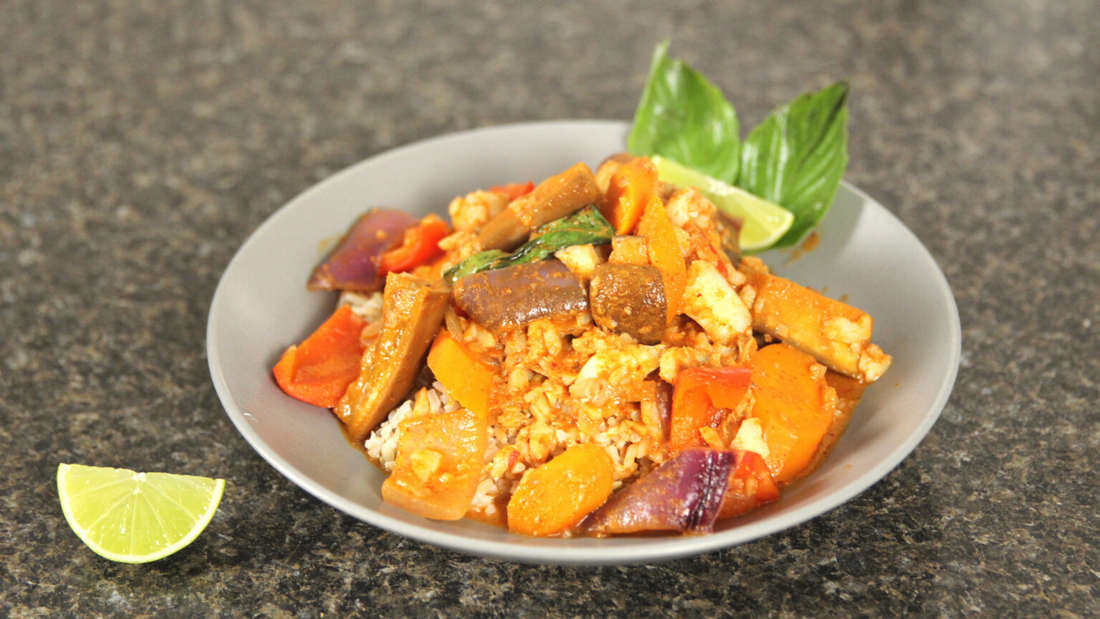
Warming Red Fish Curry
Each year, when the air got a little crisper, the days a little shorter, and the nights a little cooler, I naturally long for the warming comfort of my mom’s chicken noodle soup. In the colder months of Fall and Winter, my taste buds still seem to magically shift preferences away from crisp salads and steer towards more “hearty” foods like soups, stews, and certain spices. I also notice my eating habits move towards specific types of foods that grow in the colder months, like root vegetables, carrots, potatoes, garlic and onions. The question I wanted answered is: Why?
According to TCM, foods have energetic properties of Yin or Yang. Practitioners of TCM believe that we absorb yin (cold) or yang (hot) energy from the foods we eat, and the goal is to help our bodies find balance in the Yin & Yang by eating the right foods at the right time of the year. The combination of foods we eat needs to be in equilibrium (a balance of yin and yang) in order to be in good health.
Foods’ energetic properties can be either Warm, Cool or Neutral. Warming foods raise our yang, or energy (qi) of the body by helping to increase energy levels, improve circulation and chase away cold. (All very useful qualities in the colder months). Cooling foods, by contrast, raise the yin of the body while helping it clear toxins, reduce heat and cool the blood. There are also foods that are classified as neutral, which can act as complements to both warming and cooling foods (depending on what season you are in).

Winter represents the “most Yin” aspect in Chinese medicine: the dark, cold, slow, inward energy. Thus, the diet and activities in winter should be adapted to raise the Yang. Many of the foods that naturally grow in the fall and winter months exhibit ‘warming’ qualities help to improve circulation and nourishes the energy (qi) of our organs. These include squashes, potatoes, root vegetables, carrots, garlic, ginger, winter greens, cabbage, red peppers, onion, mushrooms, apples, and pears.
Warming Veg + White Fish Curry
Curries are great for winter. Not only are they a great way to throw together TCM warming foods like garlic, onion, carrots, mushrooms, red pepper, coconut, etc…, they’re also perfect for playing with different spices. For this recipe, I used a red curry paste with many warming spices like turmeric, cumin, red chilies, cayenne pepper, paprika, and black pepper. This recipe is gluten-free and dairy-free and could also easily be made vegan by removing the cod and just focusing on the veggies.

Start with the rice. Ideally, you should soak wild rice for 12 to 24 hours, which of course means you’ll want to plan ahead when making this recipe. Once washed and soaked, boil your rice. For one cup rice you’ll want 2 cups water. I also like to add a bit of butter (about 1 tsp). For more flavour, try boiling in vegetable broth instead of water. Once the water boils, reduce to low and simmer for 20-30 minutes (check at the 20 min mark). After removing from heat, let it rest for another 10 minutes or so.

While your rice is boiling, prep all of your ingredients. Start with the fish. Wash the fish and pad it dry. Then cut it into 2 inch pieces and season with salt and pepper. Next, you’ll want to prep all of your produce. Wash and dry everything. Mince the garlic and ginger, finely chop the sweet onion, and chop the rest of the produce (bell pepper, eggplant, mushroom, red onion and carrot) into 1-2 inch bite-sized pieces. Set all aside in separate small cooking bowls.

Now you are ready to start your curry! Warm a large skillet with deep sides over medium heat. Once it’s hot, add the oil. (I used grape-seed oil for this recipe but another high smoke point oil like coconut or ghee would be great here too.) Start sautéing your automatics. First add the sweet onion and sprinkle with a pinch of salt. Cook the onion, (stirring often), until it has softened and is turning translucent (about 3 mins). Next add the ginger and garlic, and cook for another minute, stirring continuously.

Now you are ready for the rest. Add the carrot, pepper, red onion, eggplant and mushrooms, and cook for about 3 or 4 minutes, stirring occasionally. Add the curry paste and cook, stirring often, for another 2 minutes. You want to have the paste spread out nicely. Then add the coconut milk and stir to combine. Finally, add the fish.

Once it’s all in the pan, you want to give your mixture time to simmer so that all the flavours blend together, the fish cooks throughout, and the veggies have the right texture (slightly firm). Bring the mixture to a simmer over medium heat, then reduce heat to maintain a gentle simmer and cook for 10-15 minutes. When the veggies are to your liking, stir in the basil and squeeze in the lime juice. Simmer for another 1-2 mins and remove from heat.
When ready to serve, divide the rice and curry into bowls and garnish with fresh basil. Enjoy.

Fish Red Curry Recipe
Prep Time: 25 minutes
Servings: 3-4
Ingredients:
- 1 cup wild rice
- 2 pieces white fish (I used cod)
- 1 tbsp fresh ginger (grated of finely minced)
- 2 gloves garlic (minced)
- 1 jar red curry paste
- 1 red bell pepper (chopped)
- 1 carrot (chopped)
- 1 eggplant (chopped)
- 1 red onion (chopped)
- 1/2 small sweet onion (finely chopped)
- 1 cup mushrooms (chopped)
- 1 lime (juice of)
- 1/4 cup fresh basil (I used Thai basil)
- 1 tbsp cooking oil (I used grapeseed)
- Salt & Pepper (to taste)
- 1 can coconut milk (approx 15 oz)
Directions:
- Cook the rice: Bring 2 cups water to a boil. Add rice and boil (on med) for 20-30 minutes. Remove from heat. Cover and let the rice rest for 10 minutes or longer, until you’re ready to serve.
- Wash and dry the fish. Cut into 1-2 inch pieces and season with salt and pepper.
- Wash and chop all of your produce. Mince the garlic and ginger. Finely chop the sweet onion. Cut the rest of the produce (bell pepper, eggplant, mushroom, red onion and carrot) into 1-2 inch bite-sized pieces. Set aside in separate small cooking bowls.
- Warm a large skillet with deep sides over medium heat. Once it’s hot, add the oil. Add the sweet onion. Sprinkle with salt and cook, (stirring often), until the onion has softened and is turning translucent (about 3 mins). Add the ginger and garlic, and cook for another minute, stirring continuously.
- Add the carrot, pepper, red onion, eggplant and mushrooms. Cook 3-4 minutes, stirring occasionally.
- Add the curry paste and cook, stirring often, for another 2 minutes.
- Add the coconut milk and stir to combine. Then add the fish.
- Bring the mixture to a simmer over medium heat. Reduce heat as necessary to maintain a gentle simmer and cook until the veggies have softened to your liking (about 10-15 minutes).
- Right before removing from heat, stir in the basil and squeeze in the lime juice. Simmer for another 1-2 mins.
- Divide rice and curry into bowls and garnish with fresh basil.
